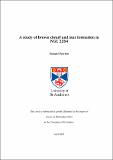Files in this item
A study of brown dwarf and star formation in NGC 2264
Item metadata
| dc.contributor.advisor | Scholz, Aleks | |
| dc.contributor.author | Pearson, Samuel | |
| dc.coverage.spatial | 211 | en_US |
| dc.date.accessioned | 2023-02-03T16:48:17Z | |
| dc.date.available | 2023-02-03T16:48:17Z | |
| dc.date.issued | 2022-11-29 | |
| dc.identifier.uri | https://hdl.handle.net/10023/26898 | |
| dc.description.abstract | Brown dwarfs are substellar objects intermediate between stars and planets that are not massive enough to sustain stable hydrogen fusion (<75Mⱼᵤₚ). They are a natural outcome of the processes that lead to the formation of stars and planets, and we find them in abundance in every environment we have searched with sufficient depth. Brown dwarfs are not rare; we find a brown dwarf for every 2 -- 5 stars, equating to tens of billions across the Milky Way. However, despite their prevalence, the inherent faintness of brown dwarfs makes studying them challenging. Many fundamental questions about these objects therefore remain unanswered, key among them: how do brown dwarfs form? The overall aim of this thesis has been to work towards this question and better understand the formation of brown dwarfs. To achieve this goal, my research has focused on brown dwarf and star formation in the young cluster, NGC 2264. The aim of studying this cluster was to build the large and well characterised sample of young brown dwarfs needed to answer the outstanding questions in the field of brown dwarf formation. Although NGC 2264 is more distant than the nearest star forming regions, I have shown that it is still accessible for detailed spectroscopic observations of young substellar objects, and crucially has the much larger population that is needed to achieve a robust statistical analysis of the key tracers of brown dwarf formation. I have identified 448 brown dwarf candidates in NGC 2264, based on a combination of NIR colours and additional signatures of youth. I have utilised follow up spectroscopy to show this selection method significantly improves selection efficiency. I find that the star-to-brown dwarf ratio and the slope of the substellar mass function for NGC 2264 are consistent with other young clusters, which points to a uniform IMF across a diverse range of star forming environments. I find no evidence for a variation in the star-to-brown dwarf ratio due to stellar surface density or the presence of OB stars. This rules out brown dwarf formation scenarios that predict strong variations in the relative frequency of brown dwarfs due to environmental conditions. Using Gaia EDR3 kinematics and photometry, I have selected a clean sample of 664 NGC 2264 stellar cluster members and divided these members into north and south sub-clusters using a K-means clustering algorithm. Through comparison with isochrones I have shown that the average age of the northern sub-cluster is ~1 Myr younger than the southern sub-cluster. Using MIR Spitzer data I have classified the disc morphology of the cluster members, based on the slope of their infrared excess. I have shown that despite the younger age of the northern sub-cluster the disc fraction is approximately the same for both the north and south (~ 40%). I attribute this dearth of northern discs to photoevaporation from S Mon, which contains a massive O7 type star - the only O type star in NGC 2264. I have shown that there is a reduction in the local disc fraction up to 1.5 pc away from S Mon, implying that O type stars have a significant and far reaching impact on the local disc lifetime. | en_US |
| dc.language.iso | en | en_US |
| dc.subject | Brown dwarfs | en_US |
| dc.subject | Star formation | en_US |
| dc.subject | NGC 2264 | en_US |
| dc.subject | Astronomy | en_US |
| dc.title | A study of brown dwarf and star formation in NGC 2264 | en_US |
| dc.type | Thesis | en_US |
| dc.contributor.sponsor | Science and Technology Facilities Council (STFC) | en_US |
| dc.type.qualificationlevel | Doctoral | en_US |
| dc.type.qualificationname | PhD Doctor of Philosophy | en_US |
| dc.publisher.institution | The University of St Andrews | en_US |
| dc.identifier.doi | https://doi.org/10.17630/sta/256 |
This item appears in the following Collection(s)
Items in the St Andrews Research Repository are protected by copyright, with all rights reserved, unless otherwise indicated.

